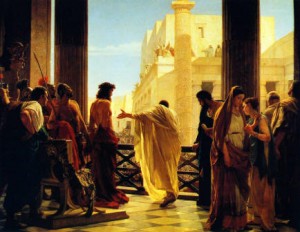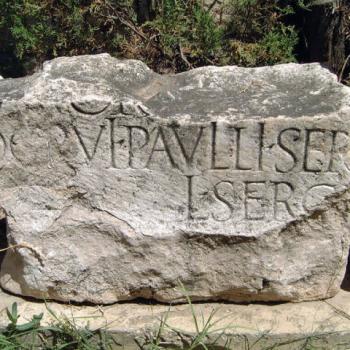The study of collective memory is very important for understanding early Christianity and its handling of its sacred traditions. This post must focus on that and related matters. Collective memory refers to memories shared by all members of the specified group based on shared experiences. One of the things that research into collective memory has shown is that the needs and interests of the present in part determine what is recalled, and what is deemed important about what is recalled.
Especially when the past is used for identity formation (.e.g. ‘remember who you are, a Hebrew whose ancestors were slaves in Egypt….’) does the present concerns and interest affect what is remembered and how it is presented. So does hagiography, by which I mean the tendency to ignore the flaws and mistakes, and polish the haloes of previous historical persons now viewed as heroes or saints. What is especially interesting about the Gospels is that they portray the disciples warts, wrinkles and all. The portraits are often not flattering, even of Peter. This needs to be borne in mind when considering the Gospel’s credibility.
One important figure in the study of collective memory as it bears on the Gospels which were written in oral cultures is Walter Ong. Here is one of his insights as cited by McIver (p.92): “Sustained thought in an oral culture is tied to communication.” He then explains how anyone (including Jesus though he does not have Jesus particularly in mind) could make sure his teachings could have been remembered over long stretches of time and by various people “Think memorable thoughts…you have to do your thinking in mnemonic patterns, shaped for ready oral recurrence. Your thoughts must come into being in heavily rhythmic, balanced patterns, in repetitions or antitheses, in alliterations and assonances, in epithetic and other formulary expressions,in standard thematic settings….in proverbs…or in other mnemonic form. Serious thought is intertwined with memory systems”. While Ong is not trying to characterize the Synoptic tradition, it is striking that all these things are found in Jesus’ teachings, especially when evaluated in the Aramaic as opposed to the Greek though most of these oral and rhetorical devices are evident in the Greek as well.
Ong goes on to describe how important story telling is in oral cultures, with stories involving vivid characters, larger than life figures, heroic deeds, dastardly crimes, violent passions, though the focus is on the deeds, not on the motives or psychological profiles. Repetition and redundancy abound and bold characterizations ( e.g. ‘unbelieving Thomas’) are characteristic.
Now when there is a collective memory of an event or a healing or a teaching or the like, there is a certain limit to the degree to which the present can distort the memory of the past, precisely because an actual happening or person is being remembered by a variety of people. For example, few would believe a person who suggested that JFK was actually shot by LBJ who was riding with him in the car. Why not? Because so many witnesses saw shots coming from one or more places outside the car (.e.g. the school book depository, the grassy knoll??). Memories of such events are of course deeply personal, but they are not private, and are subject to correction, indeed multiple corrections the more people who actually saw an event. Collective memory or social memory has a built in self-correcting nature.
In his Sixth chapter, McIver gets down to brass tacks in evaluating and critiquing various uses of the concept of collective memory as it applies to the Gospel traditions themselves, beginning with the form critical approach to traditioning of Bultmann, Dibelius, and their successors. First of all, both Bultmann and Dibelius assumed that the origins of the traditions were to be found not in the teaching of Jesus but in the early Christian communities themselves. Bultmann’s infamous dictum of 1935 was that he thought that we could now know almost nothing of what the personality of Jesus was historically like, because the early Christian communities had no interest in pure or objective historical remembering. Bultmann did think we could know a few things about Jesus’ teachings from the earliest layers of the tradition, but that was all.
Now both Bultmann, and Dibelius, assumed that the time between the time of Jesus, and the time when the Gospels were written were so great that very little of actual historical substance was remembered by the 60s and 70s. What is interesting is that this sort of whole scale creation of traditions, and lack of actual connection with the putative source of the tradition and lack of consistency between parts of the tradition is typical of people with brain injuries, as shown by recent studies cited by McIver. It is not typical of normal human beings without Alzheimer’s or brain injuries(see pp. 103-04). Normal persons can remember all kinds of things often over a half century later, especially if the person in question is someone they loved, spent time with, and cared about the opinions of. Such was the case between Jesus and his original disciples. Furthermore, outright creation of traditions about a historical persons within a generation or so of the person’s death is rare indeed due to the ongoing memories of the still living eyewitnesses. When the descendants of Betsy Ross invented the idea that George Washington asked her to sow the first flag, inventing it for the purpose of financial gain, the historical record was eventually brought to bare and it was shown this was simply a fabrication. Whole scale fabrication seldom works, and certainly is not condoned by any group that has a concern about its actual historical origins as did the earliest Christians (see Luke’s comment Lk. 1.1-4, who was a second generation non-eyewitness of Jesus). There were ‘guardians of memory’ who knew better than to treat the Jesus tradition as if it were just another legendary tale.
McIver thus concludes: “Such a wholesale invention of tradition as proposed by Dibelius and Bultmann appears inconsistent with what else is known about collective memory….the model developed by Dibelius and Bultmann to account for the development of the Gospel tradition must be rejected.” (p. 109). It accounts for neither the nature/character of the tradition, nor the way it was passed down, nor for the way collective memory actually works.
Turning to more fruitful and plausible models of tradition development in early Christianity, McIver spends time with the so-called Scandanavian school of Riesenfeld, Gerhardsson, followed by Rainer Reisner and others. While the former two focused on the traditioning process being done in a traditional Jewish, which is to say conservative manner, of handing on sacred traditions, Reisner focused on the role of Jesus as a teacher who set himself the goal of forming a collective memory of his teachings by actually discipling the Twelve and others. He points out that teacher is a job description of Jesus, not a Christological title. Jesus deliberately taught in synagogues, in homes, in the open, on the road etc. He taught wherever he went, right up to the point of his death. The notion that all this was forgotten by leaders such as Peter or James and John Zebedee, the former of which lived well into the 60s, is historically improbable, especially considering the memory studies and collective memory students McIver analyzes in this book. Importantly Riesner demonstrated that rote memorization was a staple of all early education of that period, including Jewish education.
Taking things one step further Armin Baum builds on Reisner’s work and concludes that since there is clear enough evidence of early Jews memorizing large portions of Torah, and since the sayings of Jesus amount to less words than many of them memorized (namely about 15,000 words), it is believable that Jesus had at least some of his disciples memorize large chunks of his teaching even during the ministry, since Jesus sent them out two by two to tell of his Kingdom teaching. (Baum’s book is only in German— it’s title in English would be The Orality Factor and its Meaning for the Synoptic Question 2008). Baum focuses on the various features of Jesus’ teaching that made it memorable and memorizable (see earlier C.F. Burney’s The Poetry of our Lord).
McIver next turns to the model of ‘informal controlled tradition’ advocated by Kenneth Bailey, based on his long history of living in the Middle East and observing Arab village life. His theory is the ANE was much like the modern Middle East when it comes to oral tradition. The village elders or others exercise control even in how proverbs or maxims as well as stories are told, in regard to the accuracy of their content. The obvious problem here is that while the modern Middle East is more like the first century ANE than say, North Carolina today, there are still a world of differences, and the dangers of anachronism in this model is apparent.
Drawing on the work of Bailey in a series of publications is J.D.G. Dunn who maintains as a basic assumption that the Jesus tradition remained oral for a long period of time. I have already critiqued some of Dunn’s theorizes in his Jesus Remembered volume, in a volume dedicated to Dunn and edited by Robert Stewart, so the alert reader can see that critique in the Fortress Press volume itself. If there is an emphasis in Dunn, McIver puts his finger on it— namely stressing community tradition over individual eyewitnesses. By this he means that the tradition was a living one continually used, for example the Lord’s Prayer was regularly prayed, so it was not a matter of just going and seeking out the eyewitnesses, in spite of what Luke says in Lk. 1.1-4. The problem with Dunn’s view is that it underplays the role of the eyewitnesses as the guarantors of the tradition. Dunn in the end stresses both the stability but also the flexibility of the tradition as it kept being used, adopted, and adapted in various ways.
McIver in concluding the sixth chapters stresses (pp. 120-21): 1) that Dunn seems to be most nearly right, and like Dunn he assumes that the Jesus tradition likely remained oral for a long period of time. This of course is an argument from silence, and it can be challenged in various ways, especially if one accepts the existence of Q, and for that matter recognizes that Paul talks about a formal tradition he received and passed on that involved both words and deeds of Jesus (see 1 Cor 11 and 15). 2) on the other hand McIver is right to note that Dunn undervalues the roles of those Jesus himself taught in maintaining the integrity of the tradition. It was not the community in general but its leaders who were involved most in maintaining it, especially those who could write, such as Matthew. 3) the complete rejection of the old form critical model of Bultmann and others is important, because neither memory students nor historical evidence supports their view, and yet still various persons in the Jesus Seminar (e.g. Crossan) base their arguments on such old form critical assumptions. It was not the Sitz im Lebens of the churches (situations in life) that created the traditions. It was the situations that made the using of some Jesus traditions more than others appropriate and helpful.












